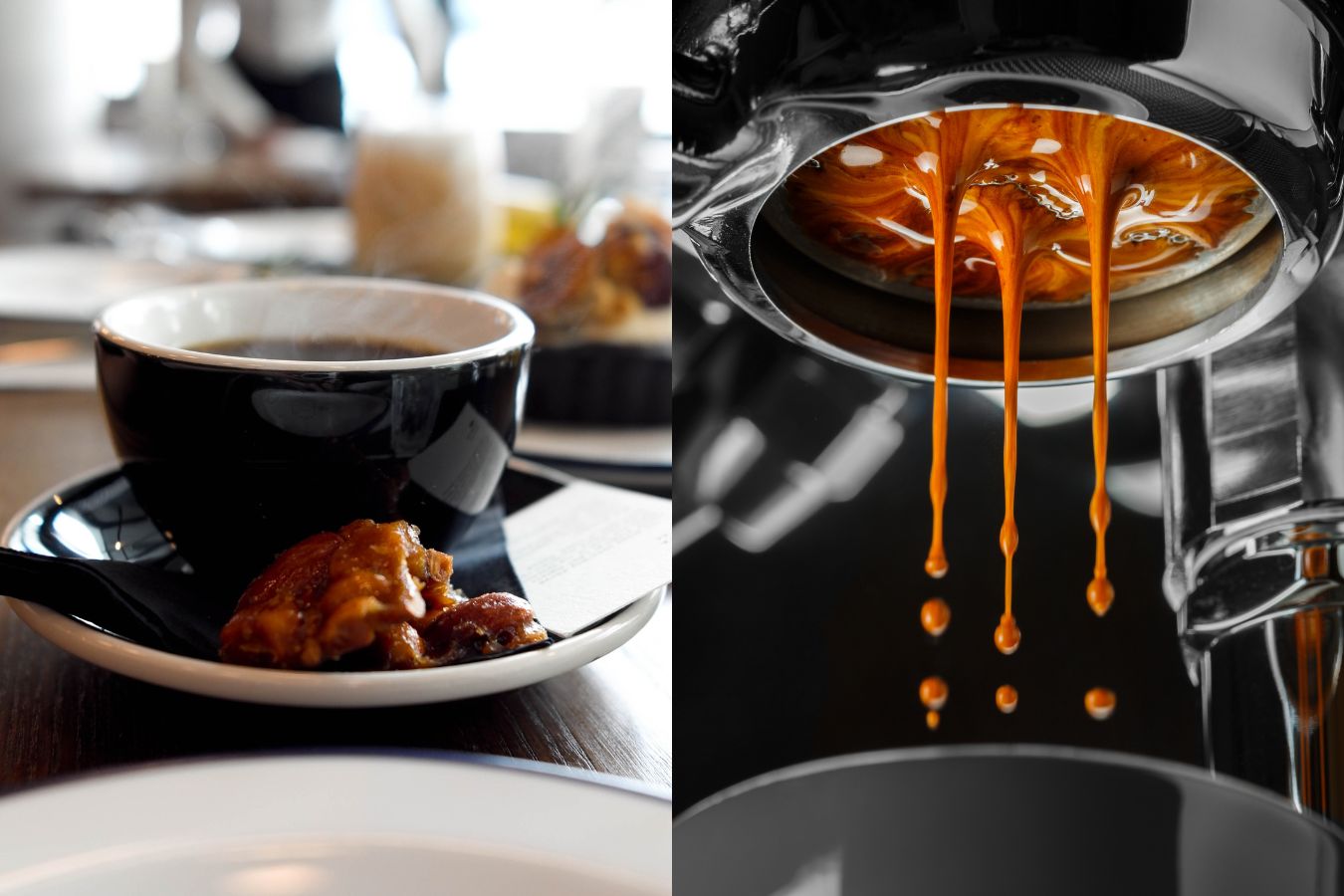Comprehending Coffee Beans: the Journey From Espresso to Blended Coffee Beans

The Beginnings of Coffee: A Worldwide Perspective
While you could consider coffee as a modern staple, its beginnings trace back centuries, linking with societies across the world. The story starts in Ethiopia, where legend claims a goat herdsman named Kaldi uncovered the invigorating results of coffee beans after observing his goats romping energetically after eating them. This stimulated interest, resulting in coffee's spread to Arab traders that treasured the brewed beverage. By the 15th century, it got to Persia, Egypt, and Turkey, where coffeehouses ended up being social centers for discussion and society.
As trade courses expanded, coffee made its way to Europe in the 17th century, promptly acquiring appeal. It changed from a magical beverage right into a day-to-day routine, intellectual exchanges and inspiring events. Each society added its one-of-a-kind twist to coffee prep work, enhancing its history. This international journey highlights how coffee links us, going beyond boundaries and uniting diverse practices with a simple bean.
Farming and Harvesting of Coffee Beans
As coffee's journey advanced, the emphasis shifted to the growing and harvesting of certain bean selections, especially those used for coffee. You'll discover that espresso beans often come from Arabica or Robusta plants, each offering distinctive tastes. The excellent growing problems include high altitudes and abundant, well-drained dirt, which enhance the beans' top quality.
During the harvest, picking approaches vary. In some regions, employees hand-pick ripe cherries, making certain just the very best fruit goes to processing. In other locations, mechanical farmers are utilized, especially on bigger ranches. When the cherries get to peak ripeness for optimum taste., timing is important; you desire to collect.
Once collected, the beans are planned for handling, which is necessary in establishing their final taste. Understanding the growing and collecting procedures gives you understanding right into what goes right into your preferred espresso, enriching your admiration for every cup.
Processing Approaches: From Cherry to Bean
Currently that you've discovered gathering espresso beans, let's explore exactly how those cherries transform into the coffee beans you love. You'll see exactly how various harvesting techniques impact flavor, complied with by the vital actions of fermentation and drying out. Finally, we'll break down the milling and grading procedure that establishes your coffee's quality.
Collecting Methods Explained
When it comes to coffee, recognizing harvesting methods is important, given that they straight influence the taste and quality of the beans you take pleasure in. Careful selecting involves hand-picking only ripe cherries, ensuring you get the best top quality beans. Ultimately, the option of collecting strategy can significantly affect your coffee experience, so it's worth recognizing just how those beans made it to your cup.
Fermentation and Drying Out
After collecting, the following action in handling coffee beans play a substantial function fit their taste. You'll locate that fermentation is important, as it assists damage down the mucilage bordering the beans, improving their taste account. Relying on the method, this process can last from a few hours to several days, with differing results based on temperature level and moisture.
Sun-drying allows the beans to absorb tastes from the environment, while mechanical drying out guarantees regular moisture degrees regardless of climate. Proper drying is vital to stop mold and mildew and maintain the beans' top quality, inevitably affecting your cup of coffee.
Milling and Grading Process
As fermentation and drying out established the phase for taste growth, the milling and grading procedure guarantees that only the ideal coffee beans make it to your mug. This phase entails getting rid of the outer layers of the coffee cherry, consisting of the parchment and husk. Top notch beans get a greater grade, resulting in a richer coffee experience.
Roasting Methods: Unlocking Flavor Potential
When you roast coffee beans, the technique you pick can considerably influence the flavor profile. Comprehending the partnership in between time, temperature level, and toasting techniques is crucial to revealing the possibility of your mixture. Let's check out just how these elements integrated to develop the best mug.
Roasting Approaches Described
While you could assume that all coffee toasting techniques produce the exact same results, the fact is that each strategy exposes special flavor possibilities in the beans. Drum roasting makes use of a rotating drum to equally distribute heat, improving caramelization and producing a balanced taste. Air roasting, on the various other hand, distributes warm air around the beans, advertising a lighter roast with obvious acidity.

Effect on Taste Profile
Various roasting techniques not just influence the procedure but also significantly affect the taste profile of the coffee beans. Dark roasts, on the other hand, bring out bold, great smoky tastes, in some cases concealing the bean's unique characteristics. Comprehending these nuances assists you value the virtuosity behind your cup of coffee, enhancing your total experience with every sip.
Time and Temperature Level Variables
To release the full taste capacity of coffee beans, both time and temperature throughout the toasting procedure play considerable roles. When roasting, you'll discover that greater temperature levels can quickly develop flavors, but if you rush it, you could finish up with burnt notes. On the other hand, lower temperature levels permit a more progressive flavor advancement, showcasing the beans' one-of-a-kind characteristics.

Timing is just as crucial; expanding the roast too long can result in a loss of acidity and illumination, while as well brief a roast could leave the beans underdeveloped. Finding that sweet spot requires practice and testing. By adjusting these variables, you can disclose the rich, intricate flavors concealed within each bean, creating an absolutely exceptional coffee experience.
The Art of Blending: Crafting Special Coffee Profiles

Start by choosing a base coffee that gives a strong foundation. A brilliant Ethiopian bean can bring fruitiness, while an abundant Brazilian coffee includes body.
As you blend, bear in mind that each combination narrates. You're not simply making coffee; you're producing an experience. Take your time, preference frequently, and delight in the trip of finding your trademark mix - Single Origin Espresso.
Developing Methods: Just How Preparation Impacts Taste
Mixing coffee opens up a domain of flavor try these out possibilities, yet just how you make that blend can considerably influence your last mug. Various brewing techniques extract special tastes and fragrances, so it's essential to select sensibly. A French press allows sediments and oils to continue to be, developing an abundant, full-bodied experience. On the other hand, a pour-over highlights the coffee's clearness and brightness, perfect for showcasing delicate notes.
Coffee, with its high stress, creates a focused shot that highlights sweetness and crema. If you favor a lighter mixture, think about a cold mixture approach; it produces a smooth, less acidic taste.
Ultimately, trial additional info and error is key. Readjusting variables like water temperature level, grind size, and brew time can transform your coffee's profile. So, embrace the art of brewing to find the tastes hidden in your coffee blends. The right technique can boost your experience to new elevations.
The Future of Coffee: Sustainability and Innovation
As the coffee sector develops, sustainability and advancement are becoming crucial for attending to ecological difficulties and conference customer demands. You'll discover that even more coffee business are adopting green techniques, from sourcing beans ethically to carrying out lasting farming techniques. These shifts not only assist the earth but also improve the top quality of the coffee you delight in.
You may see technologies like naturally degradable packaging and water-saving developing approaches that lower waste. Advanced technology, such as blockchain, is likewise ending up being prominent, making sure openness in the supply chain, which allows you to trace your coffee back to its origins.
Furthermore, purchasing regional areas and sustaining farmers via reasonable profession campaigns fosters a more sustainable coffee community. As you sip your following mug, bear in mind that your options can add to a brighter future for coffee. By choosing for lasting brand names, you're not just appreciating a beverage; you're making a favorable effect on the globe.
Frequently Asked Inquiries
What Is the Difference In Between Arabica and Robusta Beans?
Arabica beans are smoother, sweeter, and have a higher acidity, while robusta beans are stronger, more bitter, and contain even more caffeine. When making your coffee., you'll discover these distinctions in taste and aroma.
Just How Does Elevation Affect Coffee Bean Flavor?
Altitude impacts coffee bean taste substantially. Greater elevations produce beans with brighter level of acidity and facility tastes, while lower altitudes frequently generate beans that are much heavier and less nuanced. You'll discover these differences in your mug!
What Are the Health Conveniences of Alcohol Consumption Coffee?
Consuming coffee can increase your energy, boost psychological focus, and even improve physical performance. It's rich in anti-oxidants, may lower the risk of particular illness, and can promote a much healthier metabolic rate when eaten in small amounts.
Can Coffee Beans Be Reused for Brewing?
Yes, you can recycle coffee beans for brewing, however the taste could be weak. If you enjoy exploring, attempt reusing them in different means, like cold mixtures or including in healthy smoothies for an extra kick.
Exactly how Should I Shop Coffee Beans for Freshness?
To keep your coffee beans fresh, store them in a closed container in an awesome, dark area. Prevent exposing them to heat, light, or wetness, as these elements can swiftly degrade their taste and scent.
Understanding Coffee Beans: the Trip From Espresso to Blended Coffee Beans.
Currently that you've found check this out regarding gathering espresso beans, let's discover exactly how those cherries transform right into the coffee beans you like.When you roast coffee beans, the approach you choose can substantially impact the flavor account - Single Origin Espresso.While you could assume that all coffee roasting methods produce the very same outcomes, the reality is that each strategy exposes one-of-a-kind taste possibilities in the beans.Various toasting approaches not just affect the process however likewise substantially affect the flavor profile of the coffee beans
Comments on “SOE Single Origin Espresso – Ideal for Handcrafted Brewing Methods”